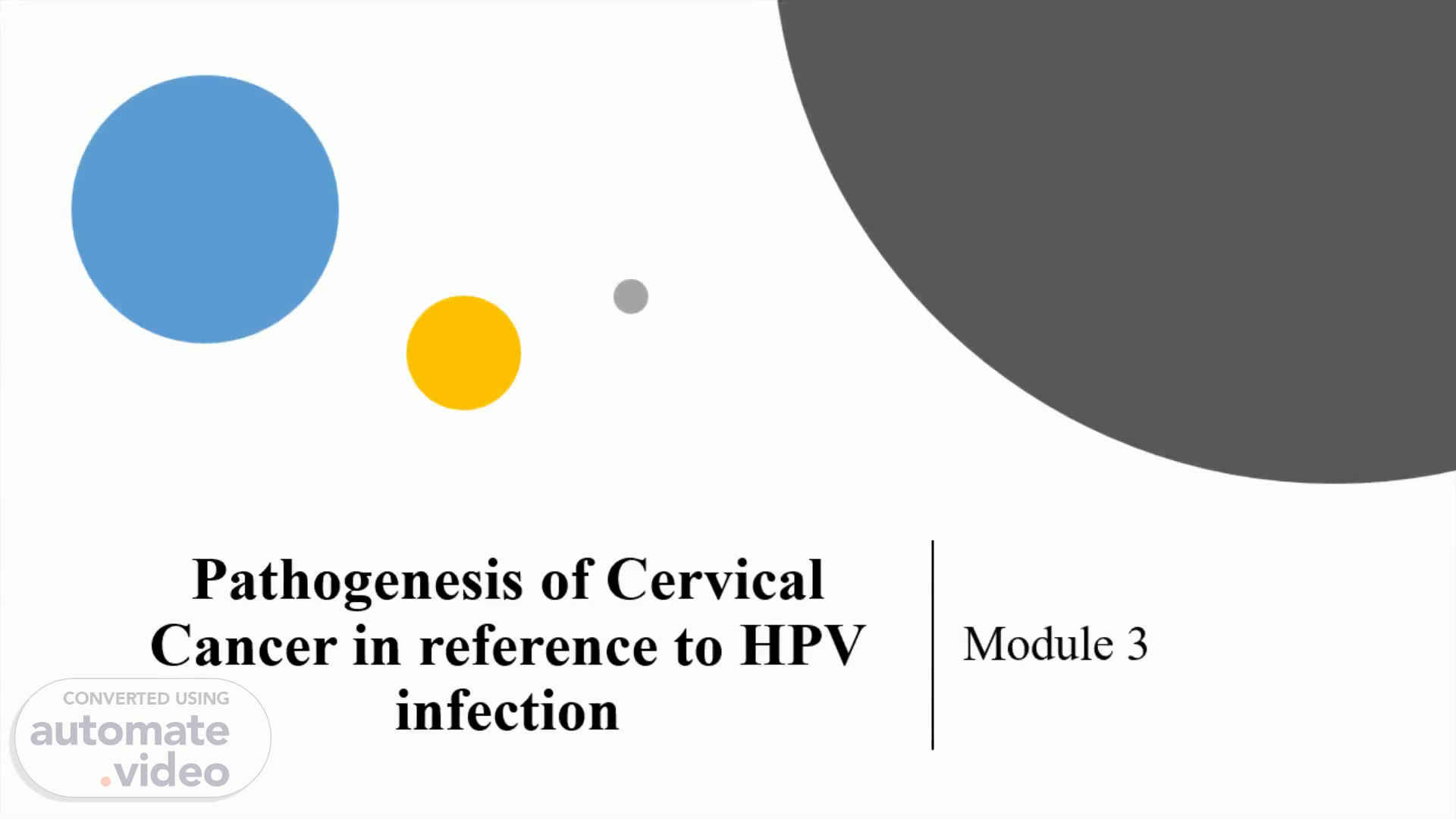
Pathogenesis of Cervical Cancer in reference to HPV infection
Scene 1 (0s)
Pathogenesis of Cervical Cancer in reference to HPV infection.
Scene 2 (8s)
Module Objectives. By end of this module, trainees will learn to I ndentify the various risk factors for cervical cancer E xplain the role of HPV infection in cervical cancer Describe the mode of transmission of HPV infection Explain the natural history of cervical cancer originating from HPV infection.
Scene 3 (23s)
Risk factors for development of cervical cancer. Age above 40 years and ever been sexually active Sexual debut at very young age Multiple sex partners or partner having multiple sex partners Too many children, specially at young age Lower socio-economic status No screening for pre-cancerous condition Smoking Homo- sexuals . HIV infection and poor immunity.
Scene 4 (41s)
Cause for cervical cancer is Persistent infection with Human Papillomavirus (HPV).
Scene 5 (49s)
Human Papilloma Virus. Capsid. DNA.
Scene 6 (56s)
sphere. HPV >100 types Ano -genital 40 types Oncogenic 16, 18, 31, 33, 35, 39, 45, 51,52, 56, 58, 59, 68, 73 & 82 Non-oncogenic 6, 11, 40 42, 43, 44, 54 Probable Oncogenic 26, 53, 66 Others.
Scene 7 (1m 14s)
HPV Types a nd Related Cancer Risk. HPV type Cancer risk 6, 11, 42 and 44 Low to negligible 16, 18 31, 33, 35, 39, 45, 51-53, 55, 56, 58, 59, 63, 66, 68 High risk Implicated in most cervical and other ano -genital cancers.
Scene 8 (1m 32s)
Human Papilloma Virus. Papilloma virus first recognized many years ago as the cause of warts on the hands and feet or condyloma accuminata on the pubic area.
Scene 9 (1m 44s)
HPV Related Cancers. Women. Cervix (Types 16 & 18 responsible for 65-75% cancers) Vulva Vagina Anus Oro-pharyngeal.
Scene 10 (1m 55s)
Spread of HPV Infection. Can occur through Sexual contact Genitalia to genitalia touch Skin to skin contact Skin to genitalia.
Scene 11 (2m 7s)
Cervical Cancer: A Rare Outcome Of HPV Infection.
Scene 12 (2m 22s)
HPV Infection & Cervical Cancer. HPV enters through small breaks in cervical epithelium near SCJ Infects basal layer of squamous epithelium Divides within cells & synchronized with epithelial cell division Moves towards surface & shed off Induces malignant process in persistent infection Viral DNA integrates into host DNA & produces harmful onco-proteins which disrupt normal regulatory mechanisms of cell division.
Scene 13 (2m 39s)
[Audio] The HPV lifecycle is restricted to the cervical epithelium; there is no viraemia. The virus is thought to infect the basal cell layer of the epithelium via microabrasions. It then uses the host cell machinery to replicate viral DNA and express virally encoded proteins. Finally, new virus particles are assembled in the upper layers of the epithelium and virus is released with the cells as they are shed from the epithelial surface. Reference Frazer IH. Nat Rev Immunol 2004; 4: 46– 54..
Scene 14 (3m 23s)
Cervical Intraepithelial Neoplasia (CIN). Persistent HPV infection and unregulated division of squamous cells of cervical epithelium lead to a pre-malignant condition known as Cervical Intraepithelial Neoplasia (CIN) Depending on severity of abnormality and extent of involvement of thickness of squamous epithelium, CIN lesions are graded as - CIN 1 (Mild dysplasia) CIN 2 (Moderate dysplasia) CIN 3 (Severe dysplasia and Carcinoma in situ) Premalignant lesions arising from columnar epithelium are known as adeno -carcinoma in situ (AIS).
Scene 15 (3m 44s)
CIN I. Also known as low grade squamous intraepithelial lesions (LSIL) Abnormal dysplastic cells limited to lower one third of epithelium Possibility of regression is 80% Progression to invasive cancer is rare.
Scene 16 (3m 57s)
CIN II. Also known as high grade squamous intraepithelial lesions (HSIL) Abnormal dysplastic cells limited to middle third of epithelium Possibility of regression is 50%.
Scene 17 (4m 9s)
CIN III. Also known as high grade squamous intraepithelial lesions (HSIL) Abnormal dysplastic cells limited to upper third of epithelium High potential for progression to cancer Possibility of regression is 30%.
Scene 18 (4m 23s)
HPV Infection. Cleared HPV Infection. Within 1 Year 1-5 Years Up to Decades CIN 2/3 Cancer.
Scene 19 (4m 36s)
Low-grade squamous intraepithelial lesion (ASCUS/LSIL).
Scene 20 (4m 47s)
Conclusion. Persistent HPV Infection is the cause of cervical cancer Multiple partners, multi-parity, smoking, age etc are the risk factors Naturally 80% of HPV infection clears off by body immunity From CIN I maximum goes back to Normal whereas from CIN III maximum progress to cancer.